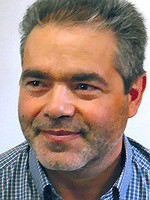abstract
We report on the effect of varying the Zn2+/Mg2+ ratio on the structure and biodegradation of glasses in an alkali-free system designed in the glass forming region of diopside (CaMgSi2O6)-fluorapatite [Ca-5(PO4)(3)F]-TCP (3CaO center dot P2O5). The zinc-containing glasses designed in the as-mentioned ternary system are potential materials for their application in bone regeneration and tissue engineering. The melt-quenched glasses with compositions (mol%), 36.07CaO - (19.24 - x) MgO - xZnO - 5.61P(2)O(5) - 38.49SiO(2) - 0.59CaF(2), where x varies between 0 and 10, have been investigated for their structure by molecular dynamics simulations as well as by nuclear magnetic resonance spectroscopy. In all the investigated glasses silicate and phosphate components are mainly present as Q(2) (Si) and Q(0) (orthophosphate) species, respectively. Zinc retains structural features similar to magnesium, with predominant five-fold coordination. The apatite-forming ability of glasses has been investigated by X-ray diffraction and infrared spectroscopy after immersion of glass powders in simulated body fluids for time durations varying between 1 h and 7 days, while their chemical degradation has been studied in Tris-HCl in accordance with ISO-10993-14. The increasing Zn2+/Mg2+ ratio decreases the chemical degradation of glasses as well as reducing their apatite forming ability. The results allowed us to discuss the biodegradation of alkali-free bioactive glasses on the basis of the structural role of zinc and magnesium.
keywords
MOLECULAR-DYNAMICS SIMULATIONS; STRUCTURE-PROPERTY RELATIONSHIPS; IN-VITRO; HUMAN OSTEOBLASTS; SILICATE-GLASSES; SOL-GEL; CHEMICAL DURABILITY; APATITE FORMATION; BIOGLASS(R) 45S5; BODY-FLUID
subject category
Materials Science
authors
Goel, A; Kapoor, S; Tilocca, A; Rajagopal, RR; Ferreira, JMF
our authors
acknowledgements
The support of CICECO, University of Aveiro and Foundation for Science and Technology (FCT), Portugal in the frame of the Project Reference PTDC/CTM/99489/2008 is acknowledged. A. Tilocca thanks the UK's Royal Society for financial support (University Research Fellowship).


